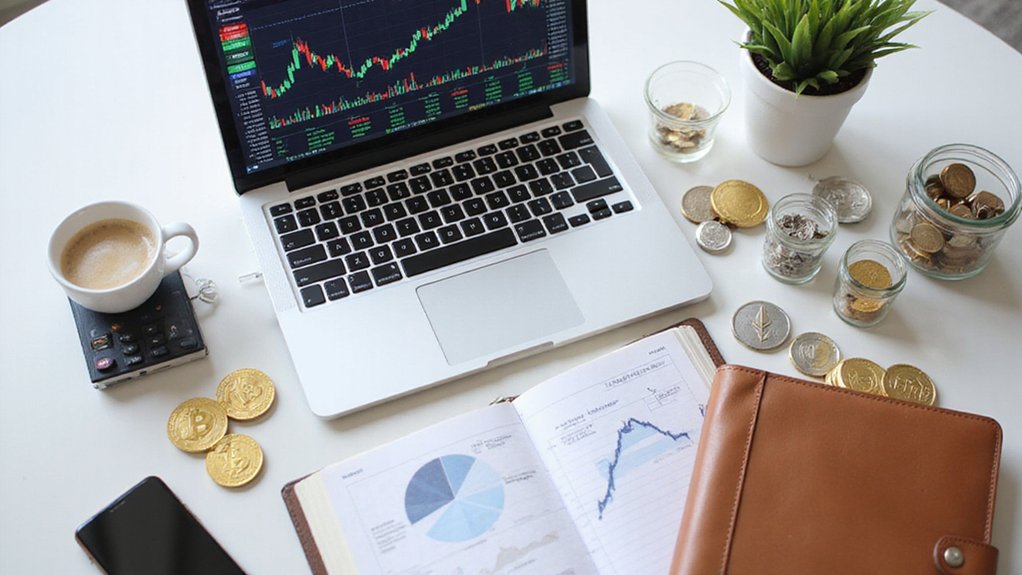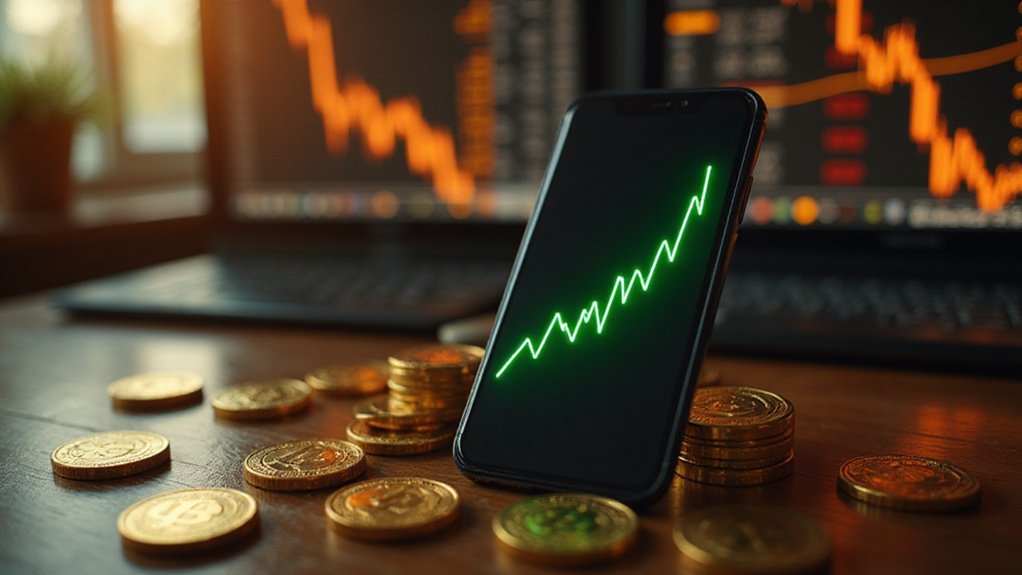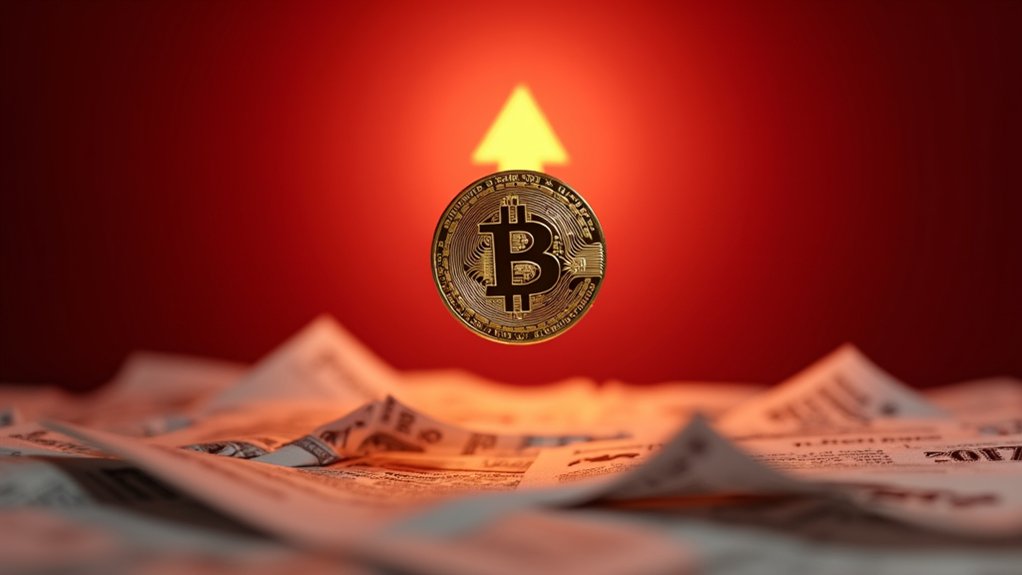Slippage represents the often unforgiving gap between expected and actual execution prices in cryptocurrency markets, where volatility and fragmented liquidity conspire to move trades against unsuspecting participants. Market orders execute ruthlessly at whatever prices the order book dictates, with substantial transactions climbing progressively expensive levels or tumbling through inadequate buy support. During volatile periods—such as the 2020 DeFi surge—slippage can exceed 200%, transforming simple swaps into costly education about market depth and the peculiar mechanics that govern digital asset execution.

How often do crypto traders discover that their meticulously planned trades execute at prices that seem to mock their original intentions?
Slippage—the divergence between expected and actual execution prices—represents one of crypto trading‘s most pervasive yet misunderstood phenomena.
While traditional finance acknowledges this reality with resigned acceptance, cryptocurrency markets amplify slippage effects through their characteristic volatility and fragmented liquidity.
The mechanics prove deceptively simple: market orders execute at whatever price the order book offers, regardless of traders’ expectations.
Market orders care nothing for trader expectations—they execute ruthlessly at whatever prices the unforgiving order book dictates.
When a substantial buy order encounters insufficient sellers at the quoted price, it necessarily moves up the order book, purchasing progressively more expensive tokens until the order fills completely.
The same principle applies inversely to sell orders, though traders often express greater dismay when reality diverges from their calculations.
Market volatility compounds these effects exponentially.
During the 2020 DeFi surge, Ethereum-based decentralized exchanges witnessed slippage increases exceeding 200% as network congestion transformed simple swaps into expensive gambles.
Low-liquidity altcoins particularly demonstrate this phenomenon, where modest orders can shift prices by several percentage points—a sobering reminder that market depth matters more than superficial spreads suggest.
Paradoxically, slippage occasionally favors traders through positive execution variance.
When rapid price movements occur between order submission and execution, traders might discover their purchases cost less or sales yield more than anticipated.
Such serendipitous outcomes rarely receive the documentation that negative slippage incidents attract, creating a perception bias that overlooks slippage’s potentially beneficial aspects.
Mitigation strategies range from elementary to sophisticated.
Limit orders provide obvious protection by establishing maximum acceptable prices, though they risk non-execution during volatile periods.
Slippage tolerance settings offer compromise solutions, permitting trades within predetermined deviation ranges while preventing egregious price impacts.
Advanced traders monitor market depth charts, schedule transactions during peak liquidity periods, and fragment large orders to minimize market impact.
Platform selection greatly influences slippage outcomes, as exchanges with deeper liquidity pools naturally provide more stable execution environments.
The irony persists that traders seeking the most explosive opportunities—typically found in emerging tokens on smaller exchanges—simultaneously expose themselves to the highest slippage risks, embodying crypto’s fundamental risk-reward paradoxes. Some jurisdictions impose new trading restrictions that can temporarily affect platform accessibility, though these regulatory developments typically aim to enhance trader protection. Decentralized platforms often exhibit significantly higher slippage rates due to their reliance on smart contracts and reduced intermediary involvement, despite offering enhanced privacy benefits. Unlike market orders that prioritize speed over price control, limit orders specify exact price constraints but sacrifice the immediacy that crypto traders often require during volatile market conditions.
Frequently Asked Questions
How Does Slippage Differ Between Centralized and Decentralized Exchanges?
Centralized exchanges typically exhibit lower slippage due to concentrated liquidity pools and sophisticated matching engines, while decentralized platforms—relying on automated market makers and fragmented liquidity—often produce higher slippage, particularly during volatile periods.
The irony? DEXs promising financial sovereignty frequently penalize users with execution costs that their centralized counterparts, despite custodial risks, manage to avoid through superior liquidity aggregation and institutional market-making relationships.
Can Slippage Be Completely Eliminated When Trading Cryptocurrencies?
Complete slippage elimination remains a trader’s impossible dream—market volatility and liquidity fluctuations guarantee some degree of price deviation inevitably occurs.
While limit orders, strategic timing, and order fragmentation can greatly minimize slippage, the inherent nature of cryptocurrency markets (with their notorious volatility spikes and liquidity gaps) makes perfect price execution perpetually elusive.
Even sophisticated OTC desks and liquidity aggregation merely reduce, never eliminate, this unavoidable trading friction.
What Is the Difference Between Positive and Negative Slippage?
Positive slippage rewards traders with better-than-expected execution prices—buying Bitcoin at $59,500 when anticipating $60,000, effectively receiving an unintended discount.
Negative slippage punishes with worse prices—purchasing that same Bitcoin for $60,500 instead.
While positive slippage feels like finding money in old jeans, negative slippage resembles paying premium prices for expired milk.
Both occur when market conditions shift between order placement and execution, though traders rarely complain about the former.
How Do Market Makers Influence Slippage Rates on Crypto Exchanges?
Market makers fundamentally act as crypto’s unsung heroes, continuously providing liquidity that cushions price volatility.
By maintaining deep order books and rapidly adjusting bid-ask spreads, they absorb trading shocks that would otherwise create substantial slippage.
Their algorithmic strategies guarantee sufficient market depth, allowing large trades to execute without dramatic price deviations.
When market makers withdraw—during extreme volatility or technical glitches—slippage rates inevitably spike, revealing their vital stabilizing influence.
Does Slippage Affect Staking and Yield Farming Returns?
Slippage barely touches staking returns, since validators lock tokens rather than trade them—making slippage concerns somewhat irrelevant.
Yield farming presents a more nuanced picture: while liquidity providers aren’t directly affected by trader slippage, they face indirect exposure when entering or exiting positions during volatile periods.
The irony? High slippage often signals thin liquidity, yet doesn’t necessarily erode farming rewards—those depend on trading volumes and fees, not price execution efficiency.









